Chengjin Xu
GraphSearch: An Agentic Deep Searching Workflow for Graph Retrieval-Augmented Generation
Sep 26, 2025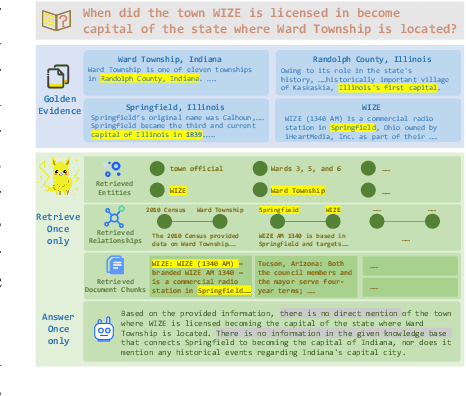
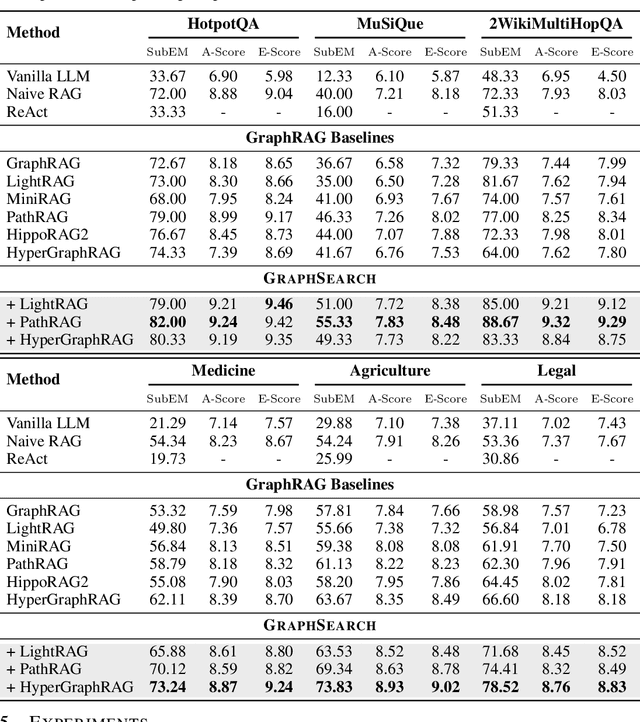

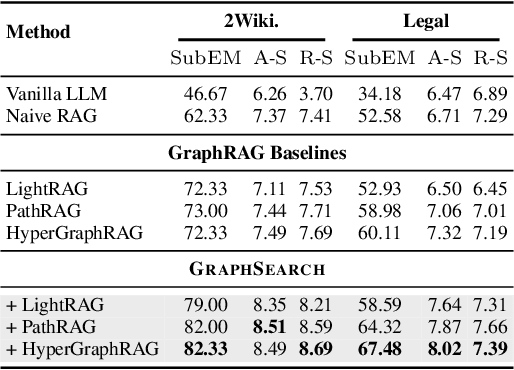
Abstract:Graph Retrieval-Augmented Generation (GraphRAG) enhances factual reasoning in LLMs by structurally modeling knowledge through graph-based representations. However, existing GraphRAG approaches face two core limitations: shallow retrieval that fails to surface all critical evidence, and inefficient utilization of pre-constructed structural graph data, which hinders effective reasoning from complex queries. To address these challenges, we propose \textsc{GraphSearch}, a novel agentic deep searching workflow with dual-channel retrieval for GraphRAG. \textsc{GraphSearch} organizes the retrieval process into a modular framework comprising six modules, enabling multi-turn interactions and iterative reasoning. Furthermore, \textsc{GraphSearch} adopts a dual-channel retrieval strategy that issues semantic queries over chunk-based text data and relational queries over structural graph data, enabling comprehensive utilization of both modalities and their complementary strengths. Experimental results across six multi-hop RAG benchmarks demonstrate that \textsc{GraphSearch} consistently improves answer accuracy and generation quality over the traditional strategy, confirming \textsc{GraphSearch} as a promising direction for advancing graph retrieval-augmented generation.
Select2Reason: Efficient Instruction-Tuning Data Selection for Long-CoT Reasoning
May 22, 2025Abstract:A practical approach to activate long chain-of-thoughts reasoning ability in pre-trained large language models is to perform supervised fine-tuning on instruction datasets synthesized by strong Large Reasoning Models such as DeepSeek-R1, offering a cost-effective alternative to reinforcement learning. However, large-scale instruction sets with more than 100k samples incur significant training overhead, while effective strategies for automatic long-CoT instruction selection still remain unexplored. In this work, we propose Select2Reason, a novel and efficient instruction-tuning data selection framework for long-CoT reasoning. From the perspective of emergence of rethinking behaviors like self-correction and backtracking, we investigate common metrics that may determine the quality of long-CoT reasoning instructions. Select2Reason leverages a quantifier to estimate difficulty of question and jointly incorporates a reasoning trace length-based heuristic through a weighted scheme for ranking to prioritize high-utility examples. Empirical results on OpenR1-Math-220k demonstrate that fine-tuning LLM on only 10% of the data selected by Select2Reason achieves performance competitive with or superior to full-data tuning and open-source baseline OpenR1-Qwen-7B across three competition-level and six comprehensive mathematical benchmarks. Further experiments highlight the scalability in varying data size, efficiency during inference, and its adaptability to other instruction pools with minimal cost.
Synthesize-on-Graph: Knowledgeable Synthetic Data Generation for Continue Pre-training of Large Language Models
May 02, 2025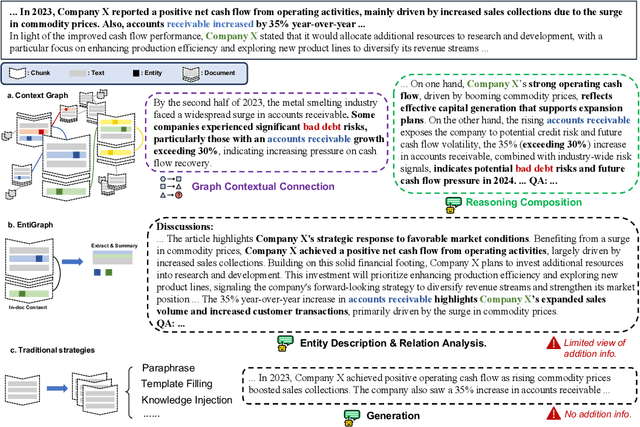
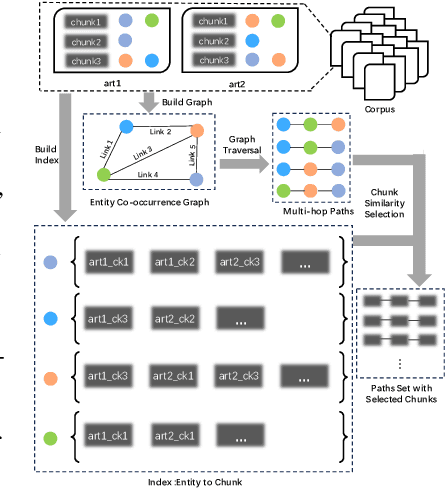

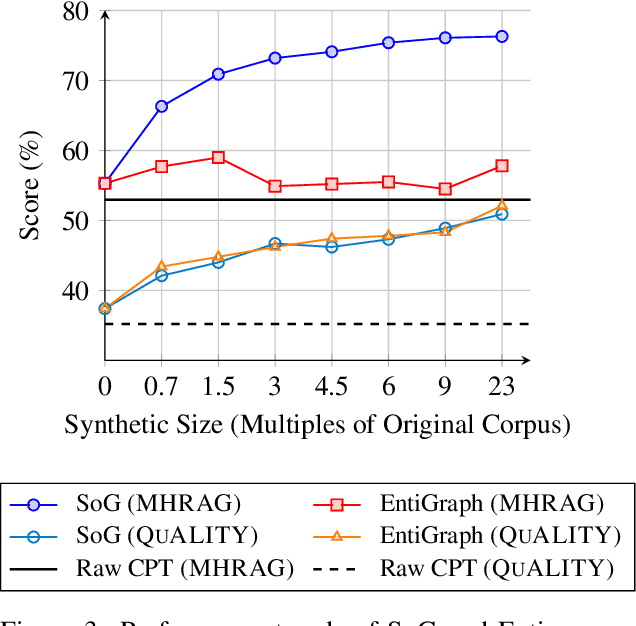
Abstract:Large Language Models (LLMs) have achieved remarkable success but remain data-inefficient, especially when learning from small, specialized corpora with limited and proprietary data. Existing synthetic data generation methods for continue pre-training focus on intra-document content and overlook cross-document knowledge associations, limiting content diversity and depth. We propose Synthetic-on-Graph (SoG), a synthetic data generation framework that incorporates cross-document knowledge associations for efficient corpus expansion. SoG constructs a context graph by extracting entities and concepts from the original corpus, representing cross-document associations, and employing a graph walk strategy for knowledge-associated sampling. This enhances synthetic data diversity and coherence, enabling models to learn complex knowledge structures and handle rare knowledge. To further improve synthetic data quality, we integrate Chain-of-Thought (CoT) and Contrastive Clarifying (CC) synthetic, enhancing reasoning processes and discriminative power. Experiments show that SoG outperforms the state-of-the-art (SOTA) method in a multi-hop document Q&A dataset while performing comparably to the SOTA method on the reading comprehension task datasets, which also underscores the better generalization capability of SoG. Our work advances synthetic data generation and provides practical solutions for efficient knowledge acquisition in LLMs, especially in domains with limited data availability.
LongFaith: Enhancing Long-Context Reasoning in LLMs with Faithful Synthetic Data
Feb 18, 2025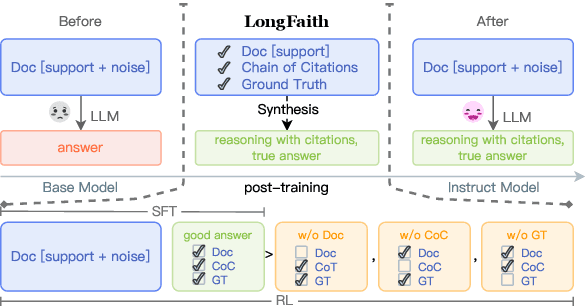
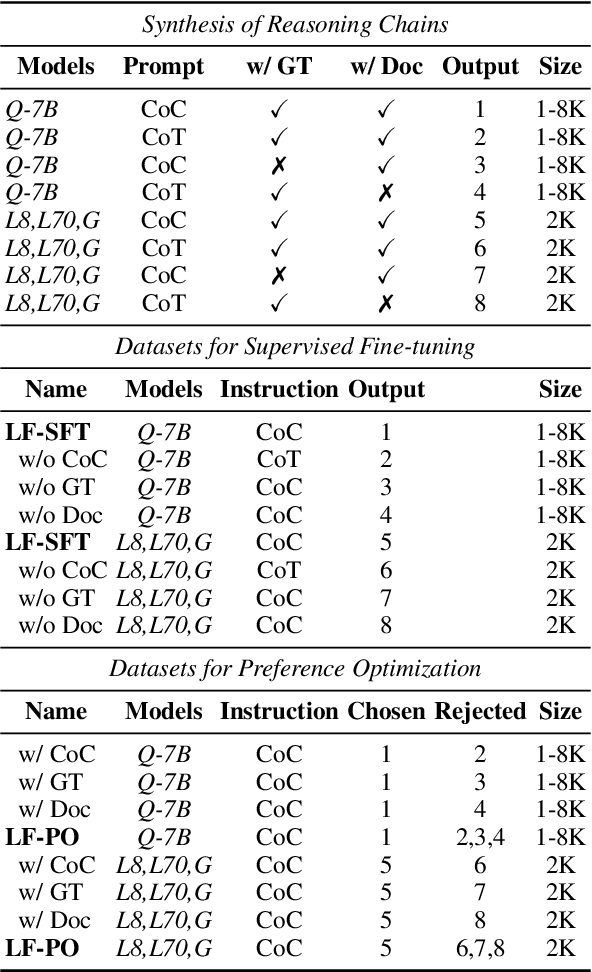
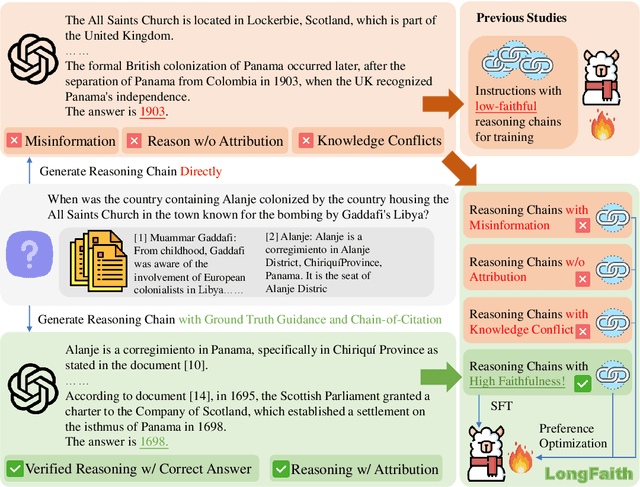
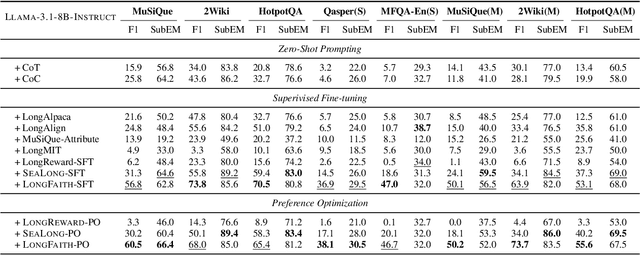
Abstract:Despite the growing development of long-context large language models (LLMs), data-centric approaches relying on synthetic data have been hindered by issues related to faithfulness, which limit their effectiveness in enhancing model performance on tasks such as long-context reasoning and question answering (QA). These challenges are often exacerbated by misinformation caused by lack of verification, reasoning without attribution, and potential knowledge conflicts. We propose LongFaith, a novel pipeline for synthesizing faithful long-context reasoning instruction datasets. By integrating ground truth and citation-based reasoning prompts, we eliminate distractions and improve the accuracy of reasoning chains, thus mitigating the need for costly verification processes. We open-source two synthesized datasets, LongFaith-SFT and LongFaith-PO, which systematically address multiple dimensions of faithfulness, including verified reasoning, attribution, and contextual grounding. Extensive experiments on multi-hop reasoning datasets and LongBench demonstrate that models fine-tuned on these datasets significantly improve performance. Our ablation studies highlight the scalability and adaptability of the LongFaith pipeline, showcasing its broad applicability in developing long-context LLMs.
A Survey on LLM-as-a-Judge
Nov 23, 2024Abstract:Accurate and consistent evaluation is crucial for decision-making across numerous fields, yet it remains a challenging task due to inherent subjectivity, variability, and scale. Large Language Models (LLMs) have achieved remarkable success across diverse domains, leading to the emergence of "LLM-as-a-Judge," where LLMs are employed as evaluators for complex tasks. With their ability to process diverse data types and provide scalable, cost-effective, and consistent assessments, LLMs present a compelling alternative to traditional expert-driven evaluations. However, ensuring the reliability of LLM-as-a-Judge systems remains a significant challenge that requires careful design and standardization. This paper provides a comprehensive survey of LLM-as-a-Judge, addressing the core question: How can reliable LLM-as-a-Judge systems be built? We explore strategies to enhance reliability, including improving consistency, mitigating biases, and adapting to diverse assessment scenarios. Additionally, we propose methodologies for evaluating the reliability of LLM-as-a-Judge systems, supported by a novel benchmark designed for this purpose. To advance the development and real-world deployment of LLM-as-a-Judge systems, we also discussed practical applications, challenges, and future directions. This survey serves as a foundational reference for researchers and practitioners in this rapidly evolving field.
Retrieval, Reasoning, Re-ranking: A Context-Enriched Framework for Knowledge Graph Completion
Nov 12, 2024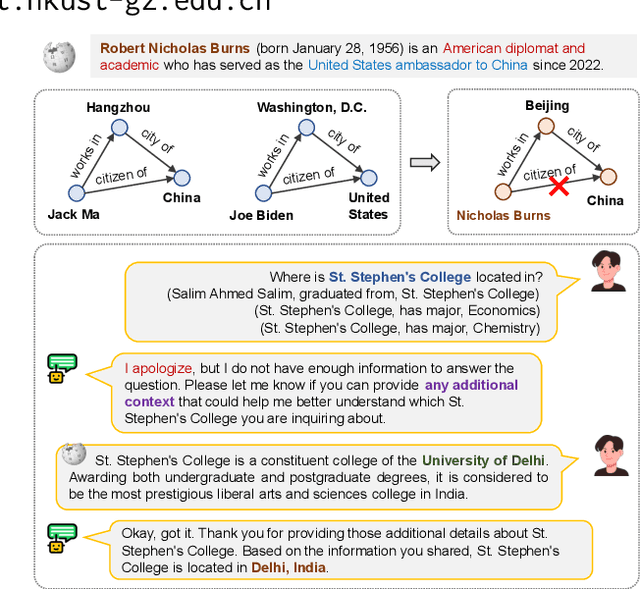
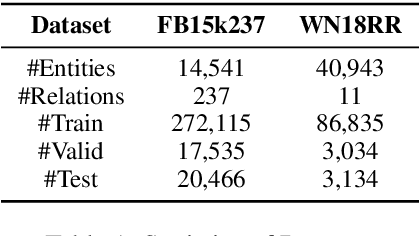
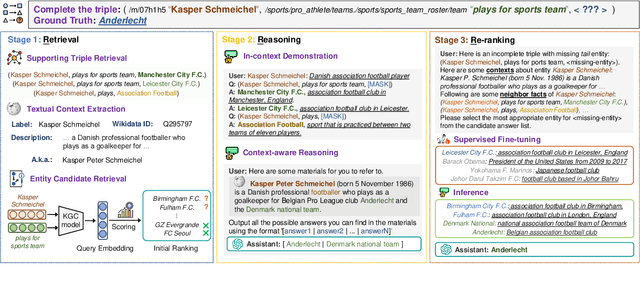
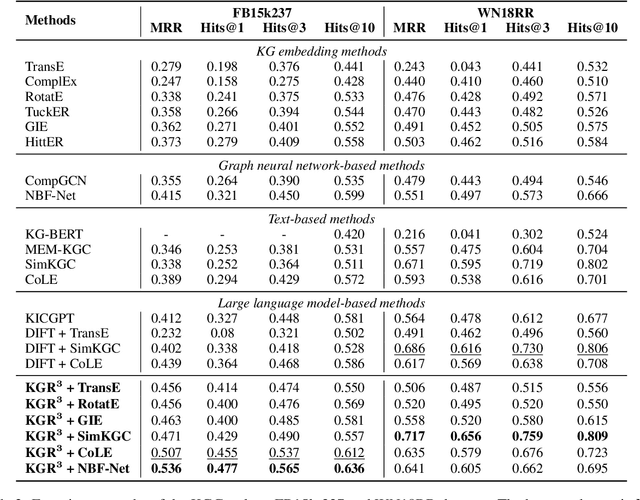
Abstract:The Knowledge Graph Completion~(KGC) task aims to infer the missing entity from an incomplete triple. Existing embedding-based methods rely solely on triples in the KG, which is vulnerable to specious relation patterns and long-tail entities. On the other hand, text-based methods struggle with the semantic gap between KG triples and natural language. Apart from triples, entity contexts (e.g., labels, descriptions, aliases) also play a significant role in augmenting KGs. To address these limitations, we propose KGR3, a context-enriched framework for KGC. KGR3 is composed of three modules. Firstly, the Retrieval module gathers supporting triples from the KG, collects plausible candidate answers from a base embedding model, and retrieves context for each related entity. Then, the Reasoning module employs a large language model to generate potential answers for each query triple. Finally, the Re-ranking module combines candidate answers from the two modules mentioned above, and fine-tunes an LLM to provide the best answer. Extensive experiments on widely used datasets demonstrate that KGR3 consistently improves various KGC methods. Specifically, the best variant of KGR3 achieves absolute Hits@1 improvements of 12.3% and 5.6% on the FB15k237 and WN18RR datasets.
Golden Touchstone: A Comprehensive Bilingual Benchmark for Evaluating Financial Large Language Models
Nov 09, 2024



Abstract:As large language models become increasingly prevalent in the financial sector, there is a pressing need for a standardized method to comprehensively assess their performance. However, existing finance benchmarks often suffer from limited language and task coverage, as well as challenges such as low-quality datasets and inadequate adaptability for LLM evaluation. To address these limitations, we propose "Golden Touchstone", the first comprehensive bilingual benchmark for financial LLMs, which incorporates representative datasets from both Chinese and English across eight core financial NLP tasks. Developed from extensive open source data collection and industry-specific demands, this benchmark includes a variety of financial tasks aimed at thoroughly assessing models' language understanding and generation capabilities. Through comparative analysis of major models on the benchmark, such as GPT-4o Llama3, FinGPT and FinMA, we reveal their strengths and limitations in processing complex financial information. Additionally, we open-sourced Touchstone-GPT, a financial LLM trained through continual pre-training and financial instruction tuning, which demonstrates strong performance on the bilingual benchmark but still has limitations in specific tasks.This research not only provides the financial large language models with a practical evaluation tool but also guides the development and optimization of future research. The source code for Golden Touchstone and model weight of Touchstone-GPT have been made publicly available at \url{https://github.com/IDEA-FinAI/Golden-Touchstone}, contributing to the ongoing evolution of FinLLMs and fostering further research in this critical area.
Context-aware Inductive Knowledge Graph Completion with Latent Type Constraints and Subgraph Reasoning
Oct 22, 2024



Abstract:Inductive knowledge graph completion (KGC) aims to predict missing triples with unseen entities. Recent works focus on modeling reasoning paths between the head and tail entity as direct supporting evidence. However, these methods depend heavily on the existence and quality of reasoning paths, which limits their general applicability in different scenarios. In addition, we observe that latent type constraints and neighboring facts inherent in KGs are also vital in inferring missing triples. To effectively utilize all useful information in KGs, we introduce CATS, a novel context-aware inductive KGC solution. With sufficient guidance from proper prompts and supervised fine-tuning, CATS activates the strong semantic understanding and reasoning capabilities of large language models to assess the existence of query triples, which consist of two modules. First, the type-aware reasoning module evaluates whether the candidate entity matches the latent entity type as required by the query relation. Then, the subgraph reasoning module selects relevant reasoning paths and neighboring facts, and evaluates their correlation to the query triple. Experiment results on three widely used datasets demonstrate that CATS significantly outperforms state-of-the-art methods in 16 out of 18 transductive, inductive, and few-shot settings with an average absolute MRR improvement of 7.2%.
ChartMoE: Mixture of Expert Connector for Advanced Chart Understanding
Sep 05, 2024



Abstract:Automatic chart understanding is crucial for content comprehension and document parsing. Multimodal large language models (MLLMs) have demonstrated remarkable capabilities in chart understanding through domain-specific alignment and fine-tuning. However, the application of alignment training within the chart domain is still underexplored. To address this, we propose ChartMoE, which employs the mixture of expert (MoE) architecture to replace the traditional linear projector to bridge the modality gap. Specifically, we train multiple linear connectors through distinct alignment tasks, which are utilized as the foundational initialization parameters for different experts. Additionally, we introduce ChartMoE-Align, a dataset with over 900K chart-table-JSON-code quadruples to conduct three alignment tasks (chart-table/JSON/code). Combined with the vanilla connector, we initialize different experts in four distinct ways and adopt high-quality knowledge learning to further refine the MoE connector and LLM parameters. Extensive experiments demonstrate the effectiveness of the MoE connector and our initialization strategy, e.g., ChartMoE improves the accuracy of the previous state-of-the-art from 80.48% to 84.64% on the ChartQA benchmark.
MLLM Is a Strong Reranker: Advancing Multimodal Retrieval-augmented Generation via Knowledge-enhanced Reranking and Noise-injected Training
Jul 31, 2024


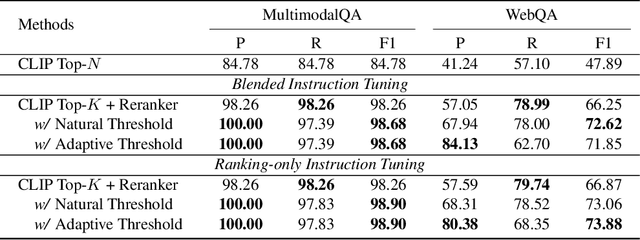
Abstract:Multimodal Large Language Models (MLLMs) have demonstrated remarkable capabilities in processing and generating content across multiple data modalities, including text, images, audio, and video. However, a significant drawback of MLLMs is their reliance on static training data, leading to outdated information and limited contextual awareness. This static nature hampers their ability to provide accurate, up-to-date responses, particularly in dynamic or rapidly evolving contexts. Integrating Multimodal Retrieval-augmented Generation (Multimodal RAG) offers a promising solution, but the system would inevitably encounter the multi-granularity noisy correspondence (MNC) problem, which involves two types of noise: coarse-grained (query-caption) and fine-grained (query-image). This noise hinders accurate retrieval and generation. In this work, we propose \textbf{RagLLaVA}, a novel framework with knowledge-enhanced reranking and noise-injected training, to address these limitations. We instruction-tune the MLLM with a simple yet effective instruction template to induce its ranking ability and serve it as a reranker to precisely filter the top-k retrieved images. For generation, we inject visual noise during training at the data and token levels to enhance the generator's robustness. Extensive experiments are conducted on the subsets of two datasets that require retrieving and reasoning over images to answer a given query. Our results demonstrate the superiority of RagLLaVA in retrieving accurately and generating robustly. Code and models are available at https://github.com/IDEA-FinAI/RagLLaVA.
 Add to Chrome
Add to Chrome Add to Firefox
Add to Firefox Add to Edge
Add to Edge